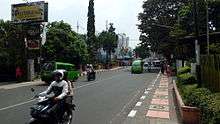Eddy Martadinata
| Eddy Martadinata | |
|---|---|
 Martadinata in 1960 | |
| Nickname(s) | R. E. Martadinata |
| Born |
29 March 1921 Bandung, West Java, Dutch East Indies |
| Died |
6 October 1966 (aged 45) Mount Riung Gunung, Pangalengan, Indonesia |
| Buried | Kalibata Heroes Cemetery (6°15′26″S 106°50′47″E / 6.25722°S 106.84639°E) |
| Allegiance | |
| Service/branch | Indonesian Navy |
| Years of service | 1945–1966 |
| Rank | Admiral |
| Awards | National Hero of Indonesia (1966) |
Admiral Raden Eddy Martadinata (often stylised R. E. Martadinata; 29 March 1921 – 6 October 1966) was an Indonesian Navy admiral and diplomat.[1] He was conferred the title of "National Hero of Indonesia" posthumously in 1966.[2] He is recognised as one of the founders of the Indonesian Navy.[3]
Biography
Martadinata was born in Bandung, West Java, on 29 March 1921. His father was Raden Ruhiyat Martadinata and his mother was Nyi Raden Suhaemi.[4] He completed his education through senior high school, first in Bandung then in Batavia (now Jakarta). After graduating high school he enrolled in a Dutch-run school for sailors in 1941, but following the Japanese occupation the following year the school was closed. He later continued, under Japanese tutelage, and by 1944 was working as an assistant teacher.[2]
Sukarno proclaimed Indonesia's independence in 1945, and in late August he established the People's Security Body (Badan Keamanan Rakjat, or BKR). Martadinata and other naval trainees began efforts to establish a naval branch of the BKR, which eventually became the Indonesian Navy.[2] During the National Revolution (1945–1949) Martadinata saw several leadership positions, including as Operating Staff Chief in Yogyakarta and Chief of Staff at the base in Surabaya.[2]
After the Dutch recognised Indonesian independence in 1949, Martadinata remained with the Navy. He oversaw naval operations in South Sulawesi in 1950, when the national government was dealing with the Makassar uprising. In 1953 he was sent to study in the United States.[5] After his return to Indonesia he supervised the purchase of various ships for the Navy.[3] After a period of infighting in the late 1950s, Martadinata replaced Subiyakto as Chief of Staff of the Indonesian Navy, leaving him in charge of the service branch; the infighting quelled soon after.[3] Martadinata rose through the ranks, reaching vice admiral by 1960.[4]
The 30 September Movement in 1965, an unsuccessful coup attempt which the government blamed on the Communist Party of Indonesia, led to massive changes in the country.[2] At a funeral for Irma, a daughter of Abdul Haris Nasution who had been killed in the coup, Martadinata indicated a wish to purge the communists;[6] this and similar communist purges led to deaths of thousands, although the total is uncertain.[7] In February 1966 Martadinata left the Navy as he perceived the government to be unwilling to deal with communists. He was reassigned as Indonesia's ambassador to Pakistan.[2]
For the 21st anniversary of the Indonesian military on 5 October 1966, Martadinata returned to the country with some Pakistani guests. The day after the ceremony, Martadinata and his guests were flying in an Aérospatiale Alouette II helicopter when the pilot crashed into Mount Riung Gunung.[2] After his body was recovered, Martadinata was buried in Kalibata Heroes' Cemetery in Jakarta.[2]
Martadinata was awarded the title of National Hero of Indonesia on 7 October 1966, based on Presidential Decree No. 220 of 1966.[8] Since then he has been the namesake for various items, including streets and a warship.[2]
References
- ↑ Ajisaka, Arya (2004). Mengenal Pahlawan Indonesia: Penuntun Belajar [Knowing Indonesian Heroes: A Study Guide] (in Indonesian). ISBN 978-979-303-470-6.
- 1 2 3 4 5 6 7 8 9 Mirnawati (2012). Kumpulan Pahlawan Indonesia Terlengkap [Most Complete Collection of Indonesian Heroes] (in Indonesian). Jakarta: CIF. pp. 181–182. ISBN 978-979-788-343-0.
- 1 2 3 "Martadinata, RE". Encyclopedia of Jakarta (in Indonesian). Jakarta City Government. Archived from the original on 3 March 2013. Retrieved 3 March 2013.
- 1 2 Iskandar, Salman (2009). 99 Tokoh Muslim Indonesia [99 Indonesian Muslim Figures] (in Indonesian). Bandung: Dar! Mizan. pp. 56–57. ISBN 978-979-752-682-5.
- ↑ Sudarmanto, J. B. (2007). Jejak-Jejak Pahlawan: Perekat Kesatuan Bangsa Indonesia [Footsteps of the Heroes: Uniting the Indonesian People] (in Indonesian). Jakarta: Grasindo. pp. 151–153. ISBN 978-979-759-716-0.
- ↑ Hughes, John (2002). The End of Sukarno – A Coup that Misfired: A Purge that Ran Wild. Archipelago Press. ISBN 981-4068-65-9.
- ↑ Ricklefs, M. C. (1993). A History of Modern Indonesia since c.1300 (2nd ed.). MacMillan. pp. 288–290. ISBN 978-0-333-57689-2.
- ↑ "Daftar Nama Pahlawan Nasional Republik Indonesia (1)" [List of Names of National Heroes of the Republic of Indonesia (1)]. Awards of the Republic of Indonesia (in Indonesian). Indonesian State Secretariat. Archived from the original on 9 May 2012. Retrieved 9 May 2012.
